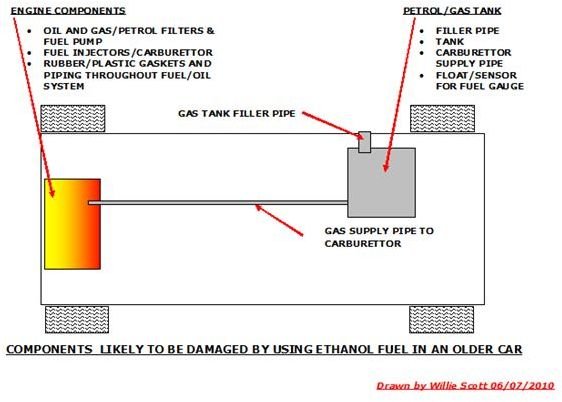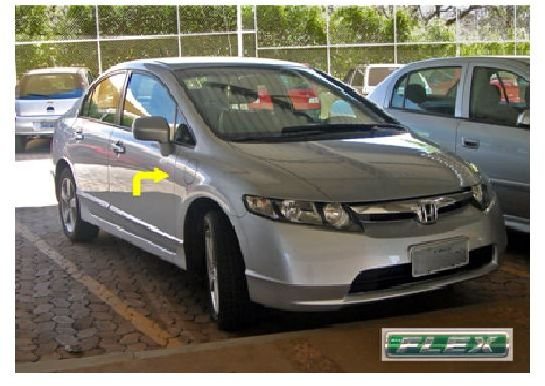Negatives of Ethanol
Introduction to the use of Ethanol in car Engines
Ethanol is being produced by many countries for use as a fuel additive in vehicle engines. The ethanol can be produced from many different crops, from sugar beets to corn and grasses.
Modern engines are designed to run on different mix ratios of gasoline/ethanol, some being capable of running on 100% ethanol.
However the older gasoline engines do need modifications to convert to gas/ethanol fuel.
This is an article on the use of ethanol as an alternative renewable energy fuel for our vehicle engines. Here we will examine the pros and cons of ethanol as an additive or replacement for hydrocarbon fuels.
We begin by having a look at the modification required to be carried out to an internal combustion engine in order to run it on an ethanol blended gasoline fuel.
Ethanol Use in Older Car Engines
Ethanol can be produced from crops for use as a primary fuel or blended with gasoline to run our modern car internal combustion engines, using blends from 10% to 100% ethanol.
However many older car engines have plastic and rubber components which can become brittle over the engine life. These components are susceptible to alcohol and can disintegrate when exposed to alcohol, causing leaks and blocking filters and fuel systems.
Also, years of accumulated dirt and sediment will have built up inside engine components, should this be washed off by the ethanol it will contaminate the engine oil and block filters eventually leading to engine seizure.
Along with this older engines will require quite significant modifications, and as we will discover ethanol, having 34% less energy per unit volume also offsets the benefits of using ethanol in the older engines. If ethanol is to be used in older engines it should therefore be restricted to lower blends such as E10.
Modifications required to the older internal combustion car engines
- Replacement parts
Various engine parts should be replaced before using ethanol mixed with gasoline. These include any plastic or rubber fuel components such as gaskets and seals, fuel/oil filters, and fuel spill pipes. Fuel tanks, filler pipe and fuel supply lines should also have a professional inspection for corrosion.
- Combustion air/gas or exhaust gas ratio sensors
Sensors are required to be fitted in the fuel and/or exhaust systems which analyze the gas/air ratios. This info is then fed to an on-board computer that adjusts the air/fuel ratio to ensure that optimum stoichiometric conditions are maintained.
- Engine Knock
Ignition timing will be required to be adjusted to prevent engine ‘knock’.
- Compression Ratio
The higher octane rating of ethanol enables the compression ratio to be increased; raising the engine thermal efficiency. However it is quite a major operation to strip an engine and fit high compression pistons, so payback period would probably prohibit this alteration to the older car engine.
Negative Effects of Using Ethanol in Modern Engines
- 1. 25% - 50% less MPG
This is due to the lower density energy of ethanol compared to petroleum.
To combat this fuel inefficiency modern engines can be designed to run on up to E80 ethanol, incorporating the following adaptations;
Compression Ratio
- The compression ratio is increased to above 19-1.
Engine Fine Tuning
- The engine can be being very finely tuned and maintained by the constant monitoring/control of the inlet fuel/air and exhaust by the on-board computer to give optimum stoichiometric conditions. When using neat ethanol (E100) the increase in thermal efficiency and computer control returns an mpg comparable to a normal petroleum fueled engine.
2. Problems with Cold Start
Cold start problems are due to globules of water contained within the ethanol and is particularly prevalent in high percentage mixes of 90% ethanol and above.
To Combat Cold Start a few measures and conversions are in place;
Local legislation
- Countries which experience cold winters have introduced legislation which caps the ethanol mix at a maximum of 85% (E85)
Double Fuel Tanks
- Another method to combat cold start problems when using ethanol is to fit an additional small fuel tank located close to the engine compartment, specifically to hold normal gasoline. When experiencing cold start problems, pure gasoline is supplied to the fuel system thus enabling a normal start.
Research and Development into Ethanol Use
Ethanol use in Hybrid Car Engines
The emissions from a hybrid car (petrol/electric) can be further improved by the use of ethanol at up to E80 blend in a modern engine; emissions have reportedly been cut by up to 30%. The double fuel tank system as explained in previous section is incorporated to avoid cold start problems.
Ethanol use in Compression Ignition Engines
There have been a few successful attempts to design an engine based on the diesel compression/ignition cycle.
The engine is of high compression ratio of around 20-1 ratio, with 93.6 ethanol used. An ignition improver which enables the ethanol to be compression ignited is added to this at 3.6 % and denaturants of 2.8%, the fuel is known as ED95.
Scania Engines of Sweden have designed one such engine to run on this fuel and Sweden has had a fleet of busses and waste collection vehicles running on ED95 for many years.
Sketch Showing E10 use Trouble Spots and Photo of Flexi-fuel Honda with Dual Fuel Tank (www.agmrc.org)

Internet Sites Visited
https://www.fuel-testers.com/ethanol_engine_precautions.html
https://www.scania.com/media/pressreleases/n10018en.aspx
https://www.agmrc.org/renewable_energy/ethanol/brazils_ethanol_industry__part_two.cfm
